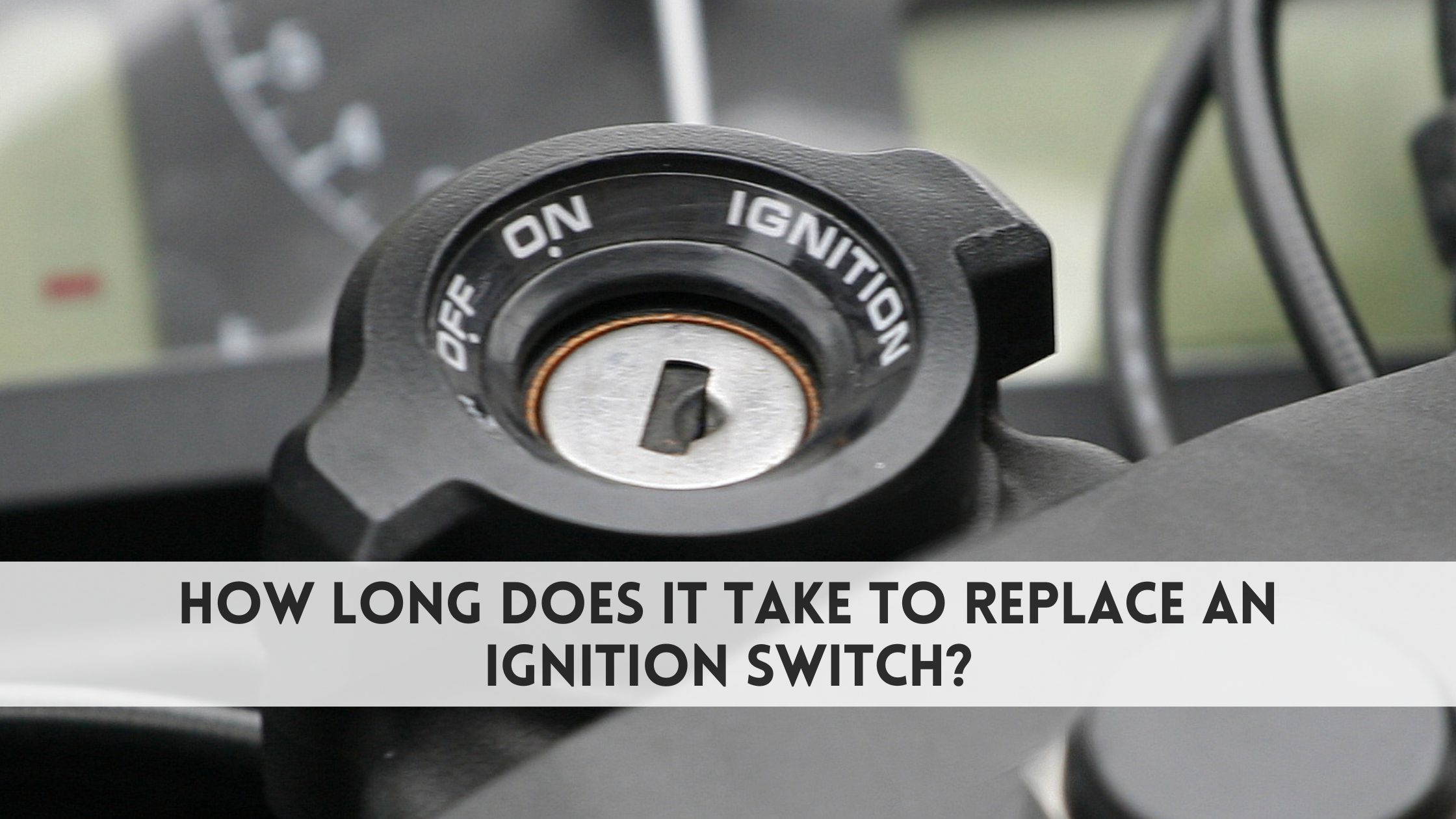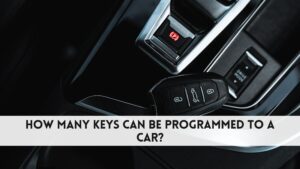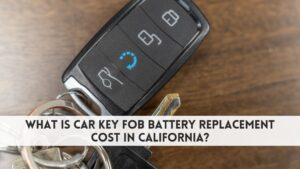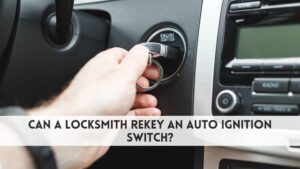The ignition switch is a critical component of your vehicle’s electrical system, responsible for initiating the engine start-up process and supplying power to essential systems like the starter motor, fuel pump, and dashboard electronics. So, how long does it take to replace an ignition switch? Whether you turn a traditional key or press a push-button start, the ignition switch plays a vital role in completing the circuit that powers your vehicle.
Over time, ignition switches can wear out due to repeated use, internal electrical failures, or key mechanism issues. A faulty ignition switch can cause starting difficulties, intermittent power loss, or even complete engine failure, making it impossible to operate your vehicle safely. Consider replacing the ignition switch if your car fails to start or stalls unexpectedly.
The process depends on factors like the type of vehicle you have, the complexity of the ignition system, and how you choose a professional locksmith. In this guide, we’ll explore ignition switch replacement time, signs of failure, replacement procedures, and safety concerns, ensuring you have the right information to address the issue efficiently.
How long does it take to replace an ignition switch?
The time required to replace an ignition switch varies depending on several factors, such as the car model, the accessibility of the ignition switch, and choosing a professional locksmith.
| Replacement Type | Estimated Time | Complexity Level |
| Professional Locksmith | 30 minutes – 1 hour | Easy |
| Dealership Service | 1 – 2 hours | Medium |
| Mobile Auto Technician | 45 minutes – 1.5 hours | Medium |
| Older or Luxury Vehicles | 2+ hours | High |
Professional Locksmith: The Fastest and Most Cost-Effective Option
Hiring a professional locksmith is the fastest and most efficient way to replace an ignition switch. Locksmiths specialize in vehicle lock and key systems, making them highly skilled at ignition switch replacements. Unlike dealerships that require appointments and paperwork, a locksmith can replace your ignition switch on-site, usually within 30 minutes to 1 hour.
This eliminates the hassle of towing your vehicle to a repair shop, saving both time and money. Additionally, locksmiths often charge lower labor costs compared to dealerships, making this the most cost-effective choice. If you need a quick, reliable, and affordable ignition switch replacement, calling an experienced automotive locksmith ensures your car is back on the road quickly and safely.
Dealership Service: Longer Wait Times and Higher Costs
Replacing an ignition switch at a dealership is often more expensive and time-consuming than hiring a locksmith. Dealerships require you to schedule an appointment, which may result in longer wait times depending on their availability. Additionally, the process involves extensive paperwork, labor charges, and administrative fees, increasing the total replacement cost.
Expect the service to take 1 to 2 hours, excluding the time spent waiting for an available technician. Furthermore, you must transport your vehicle to the dealership, which can be inconvenient if your ignition switch has already failed. While dealerships ensure OEM parts and brand-certified service, they are generally not the fastest or most affordable option for ignition switch replacement compared to locksmiths or mobile auto technicians.
Mobile Auto Technician: Convenient On-Site Repair Solution
A mobile auto technician offers a convenient alternative to dealership repairs, as they come directly to your location. This service is ideal for those who don’t want to tow their vehicle or visit a repair shop. Mobile technicians specialize in on-the-go vehicle repairs, including ignition switch replacement, and typically complete the job in 45 minutes to 1.5 hours, depending on the complexity of your vehicle.
They bring all necessary tools and replacement parts, ensuring an efficient and hassle-free repair. While slightly slower than a locksmith, mobile auto technicians provide a balance between affordability and convenience, making them a great choice for those needing ignition switch replacement at home, work, or on the road.
Older or Luxury Vehicles: Complex Ignition Systems Require More Time
Replacing an ignition switch in older or luxury vehicles often takes longer due to more intricate security systems and complex dashboard layouts. Luxury brands such as BMW, Mercedes, Audi, and Lexus use advanced electronic ignition switches that may require key reprogramming or additional steps, increasing the total replacement time.
Additionally, older vehicles may have ignition switches located in hard-to-reach areas, requiring extra labour to remove panels or disassemble steering components. Because of these factors, ignition switch replacement in high-end or older vehicles can take 2+ hours. If you own a luxury or classic car, it’s best to consult a specialist mechanic or locksmith with experience handling complex ignition systems to ensure a smooth and professional replacement process.
How Do I Know If My Ignition Switch Needs to Be Replaced?
A failing ignition switch can cause a variety of issues, from difficulty starting the vehicle to unexpected engine stalling. Since the ignition switch is responsible for distributing power to the starter motor, fuel system, and vehicle accessories, a malfunction can lead to serious safety risks.
If you’re experiencing starting issues, electrical malfunctions, or intermittent power loss, it might be time to replace your ignition switch. Below are the most common warning signs and how they impact your vehicle.
Key Won’t Turn or Gets Stuck in the Ignition
One of the most obvious signs of ignition switch failure is difficulty turning the key. If the key:
- Doesn’t turn smoothly when inserted
- Gets stuck in the ignition cylinder
- Requires extra force to turn
This could indicate internal wear and tear within the ignition switch. Over time, the internal tumblers or electrical contacts inside the switch may degrade, making it difficult for the key to engage properly.
Possible Causes:
- Worn-out ignition switch contacts
- Dirt, dust, or debris buildup inside the ignition cylinder
- A damaged key that no longer fits properly
Ignoring this problem can eventually lead to complete ignition failure, leaving you stranded.
Car Won’t Start Despite a Fully Charged Battery
If your battery is in good condition but the engine doesn’t crank or start when turning the key, the ignition switch might not be sending power to the starter motor.
Symptoms of Ignition Switch Failure in This Case:
- No sound (clicking or cranking) when turning the key
- Interior lights and dashboard indicators work, but the car won’t start
- The starter motor is not engaging
The ignition switch controls the power flow from the battery to the ignition system. A faulty switch means the starter motor and fuel pump won’t receive power, preventing the engine from starting.
How to Diagnose?
- Test the battery voltage to ensure the issue isn’t a dead battery.
- Check the starter relay to rule out starter motor issues.
- If both components are working fine, the ignition switch is likely the problem.
Engine Stalls While Driving
A failing ignition switch can cause the engine to lose power unexpectedly, leading to dangerous situations on the road.
What Happens When the Ignition Switch Fails Mid-Drive?
- The engine shuts off suddenly, even at high speeds
- Power steering and brakes may become unresponsive
- Dashboard warning lights may flicker before the stall
This issue occurs because the ignition switch loses electrical contact, momentarily cutting power to the fuel system and engine control unit. If left unchecked, the problem worsens over time, making your vehicle unreliable.
Safety Warning:
Driving with a failing ignition switch is highly dangerous, as it can cause loss of control while driving. If your engine stalls unexpectedly, have the ignition switch inspected and replaced immediately.
Dashboard Lights Flicker or Fail to Turn On
The ignition switch supplies power to various electrical systems, including:
- Dashboard indicators and warning lights
- Headlights and brake lights
- Radio, air conditioning, and power windows
If these electrical components flicker or fail, it could mean the ignition switch isn’t delivering consistent power.
Signs of Ignition Switch Electrical Issues:
- Flickering dashboard lights when turning the key
- The radio or AC turns off randomly while driving
- Interior lights and accessories work intermittently
Why Does This Happen?
A failing ignition switch loses electrical contact, resulting in intermittent power supply. If left untreated, the issue could progress to complete failure, leaving you unable to start the car.
Accessories Stop Working in the “ON” Position
When you turn the key to the “ON” position, your car’s electrical systems should activate, even if the engine hasn’t started yet.
If your:
- Headlights, radio, or air conditioning fail to turn on
- Power windows don’t work
- Windshield wipers or dashboard instruments stay off
Then the ignition switch may not be distributing power correctly to your vehicle’s electrical components.
This issue often indicates that the electrical contacts within the switch are worn out and no longer sending signals properly. Replacing the ignition switch is the best solution to restore power flow.
Overheating or Burning Smell from the Ignition
A burning smell near the ignition switch is a serious warning sign of electrical failure. It could mean:
- The ignition switch is overheating due to excessive resistance
- A short circuit is developing inside the switch
- Melted wiring could lead to a potential electrical fire
If you notice a burning smell, stop using the ignition immediately and have your vehicle inspected by a professional.
Why Does This Happen?
Over time, ignition switches wear out due to prolonged electrical load, causing:
- Excessive heat buildup
- Damage to surrounding wiring
- Potential fire hazards
If ignored, this issue can cause permanent electrical damage to your vehicle, leading to costly repairs.
Intermittent Starting Issues
Does your car start sometimes but fail at other times?
If you experience:
- The car started fine one day but refused the next
- The key is turning ,but the engine is not responding randomly
- Unpredictable power loss or electrical issues
Then your ignition switch is likely failing intermittently.
Why Is This Dangerous?
- Unreliable ignition performance can leave you stranded unexpectedly.
- The issue worsens over time, eventually leading to complete failure.
- Driving with an unpredictable ignition system can lead to sudden breakdowns.
If your car exhibits intermittent starting problems, it’s best to replace the ignition switch before it completely stops working.
How Do Locksmiths Replace an Ignition Switch?
A professional locksmith follows a structured process to safely and efficiently replace an ignition switch without causing damage to the vehicle. This process ensures a smooth transition from the faulty ignition switch to a fully functional one, restoring the vehicle’s ability to start properly.
Diagnose the Problem
Before replacing an ignition switch, a locksmith first diagnoses the issue to confirm whether the switch is faulty. Common symptoms include the key not turning, intermittent stalling, or complete ignition failure. The locksmith may use diagnostic tools to check for electrical continuity, ensuring that the issue isn’t related to the battery, starter motor, or ignition cylinder.
In some cases, a faulty key or immobilizer system may be the root cause, and replacing the ignition switch may not be necessary. A professional locksmith will ensure an accurate diagnosis before proceeding with the replacement, saving both time and money. This step is crucial because misdiagnosing the problem could lead to unnecessary repairs and additional costs.
Disconnect the Battery
To prevent electrical shorts and accidental sparks, the locksmith disconnects the battery before working on the ignition switch. Since the ignition system is directly linked to the vehicle’s electrical components, failure to disconnect the battery could lead to damage to the car’s electronics or even cause injury.
The standard procedure involves removing the negative terminal first, followed by the positive terminal. This ensures that no electrical current flows through the system while the replacement is in progress. Disconnecting the battery also prevents the vehicle’s airbags from deploying accidentally, which is a critical safety precaution, especially in modern cars equipped with advanced security systems.
Remove Steering Column Cover
The ignition switch is typically located within the steering column, so the locksmith carefully removes the plastic casing surrounding it. Depending on the vehicle, this may require screwdrivers or specialized tools to loosen screws or clips holding the cover in place.
In some cars, removing the steering wheel may also be necessary, requiring a steering wheel puller tool. However, a professional locksmith will have the expertise to determine the most efficient method. This step must be done gently to avoid breaking clips or damaging wiring, as some modern vehicles have sensitive electronic components integrated within the steering column.
Unplug and Remove the Old Ignition Switch
Once the steering column cover is removed, the locksmith locates the ignition switch and carefully disconnects it from the wiring harness. The ignition switch is usually secured with small screws or bolts, which are loosened using precision tools.
During this step, the locksmith ensures that the wires are not damaged, as improper handling can cause electrical failures or dashboard warning lights to appear after installation. The faulty ignition switch is then gently removed from its housing, making space for the new component. If the vehicle has an anti-theft system, the locksmith ensures that the replacement switch is compatible with the car’s security system.
Install the New Ignition Switch
With the faulty switch removed, the new ignition switch is carefully installed into its designated slot. The locksmith secures it in place by tightening the screws or bolts and reconnecting the wiring harness.
If the ignition switch is part of a push-to-start system, it may need to be reprogrammed to work with the vehicle’s immobilizer system. Some modern cars require programming tools to synchronize the new ignition switch with the ECU (Engine Control Unit). A professional locksmith will use manufacturer-approved tools to ensure that the installation is done correctly, preventing compatibility issues.
Test the Ignition System
Before finalizing the process, the locksmith conducts a series of tests to ensure the new ignition switch is functioning correctly. This includes:
- Turning the key or pressing the start button to verify that the engine starts smoothly.
- Checking that the steering wheel lock disengages properly when the key is inserted.
- Ensure that dashboard lights and accessories (radio, AC, windows) receive power.
- Running a safety check to detect any warning lights related to the electrical system.
If any issues arise, the locksmith makes necessary adjustments or resets the vehicle’s security system before handing the car back to the owner. A successful ignition switch replacement restores full functionality to the vehicle, ensuring safe and reliable operation.
Can You Drive With a Faulty Ignition Switch?
Driving with a faulty ignition switch is dangerous because it can lead to:
Sudden Engine Stalling
A faulty ignition switch can cause sudden engine stalling, which is highly dangerous, especially while driving at high speeds or in heavy traffic. When the ignition switch fails, it disrupts the connection between the battery and the engine, causing the car to shut off unexpectedly. This increases the risk of accidents, loss of control, and roadside breakdowns.
If your engine stalls while driving, you may lose power steering and braking, making it harder to maneuver safely. Vehicles with faulty ignition switches often experience random shutdowns that can worsen over time. If your car is stalling intermittently, it’s a strong indication that the ignition switch needs immediate replacement. Ignoring the issue can lead to a complete system failure.
Inconsistent Electrical Functions
A failing ignition switch disrupts power distribution to essential electrical components, causing inconsistent functionality in airbags, dashboard lights, power windows, and headlights. Since modern vehicles rely heavily on electrical systems, an unstable ignition switch can lead to malfunctioning instrument panels, flickering dashboard lights, and sudden power loss. More critically, it can prevent airbags from deploying in an accident, increasing injury risks.
Additionally, issues like radio failures, non-responsive power locks, and intermittent AC function can signal ignition switch failure. Over time, this inconsistency can worsen, making your vehicle unreliable and unsafe. Replacing the ignition switch early ensures all electrical components receive a steady power supply, preventing further damage and costly repairs.
Complete Ignition Failure
If an ignition switch problem is ignored for too long, it can lead to complete ignition failure, making the car impossible to start. When the internal switch components wear out, they can no longer provide the necessary electrical connection between the key and starter motor. This can result in a completely dead ignition system, leaving you stranded without warning.
In some cases, the key may get stuck in the ignition, making it impossible to turn. Replacing the ignition switch before it fails can save you from unexpected breakdowns and expensive towing fees. If you experience frequent starting issues, have your ignition system checked by a professional locksmith or mechanic to avoid complete failure.
Is It Safe to Drive With a Faulty Ignition Switch?
| Situation | Risk Level |
| Engine Stalls Occasionally | High |
| Key Gets Stuck Frequently | Medium |
| Car Won’t Start at All | Severe (Un-driveable) |
Final Words
Replacing an ignition switch is a crucial repair that typically takes 30 minutes to 2 hours, depending on your vehicle model and options for a professional locksmith.. A faulty ignition switch can lead to starting issues, engine stalling, and even complete ignition failure, making it a safety hazard if left unaddressed.
If you notice warning signs like difficulty turning the key, inconsistent electrical functions, or sudden engine shutdowns, it’s essential to replace the ignition switch immediately. Avoid driving with a failing ignition switch to prevent unexpected breakdowns. For a hassle-free experience, always consult an expert to ensure the ignition switch is replaced correctly and safely.












